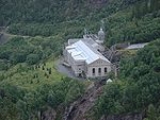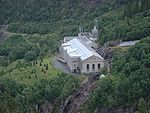
Norwegian Industrial Workers Museum
Encyclopedia
Norwegian Industrial Workers Museum is an industrial
museum
located at Rjukan
in Tinn
, Norway
. Located in the Vemork
power station, it was established in 1988 to allow the preservation of industrial society created by Norsk Hydro
when they established themselves in Rjukan in 1907.

, electrochemical industry and the premise for the workers. In particular local heritage from Tinn and the Norwegian heavy water sabotage
are given high priority.
and the labour unions Norwegian Confederation of Trade Unions
, Norwegian Workers Education Association, Norwegian Union of Chemical Industry Workers and EL & IT Forbundet
. Later this was supplemented by the United Federation of Trade Unions
, Statkraft
and Statnett
, but the latter two have since left. The museum moved in to the Vemork
power station, since Norsk Hydro had abandoned the hydrogen
plant in 1971—and the first plant in the world to mass produce heavy water
. The first curator
was hired in 1984, followed by two more employees in 1985. This phase of the establishing had a widespread goal, attempting to preserve both pre- and post-industrial heritage from Rjukan, including the establishment of Tinn Museum, a heritage village dedicated to the preindustrial society, in 1984. The permanent exhibition at Vemork was opened on June 20, 1988.
In 2004 Tinn Museum was integrated into the Norwegian Industrial Workers Museum; which has the responsibilities for preserving local history from Tinn. This includes a digitalized collection of more than 30,000 photographies. The industry at Rjukan had its own railway, Rjukanbanen
, that connected to the Tinnsjø railway ferry
. In 2004 the foundation running the heritage railway was discontinued, and in 2007 the Norwegian Industry Workers Museum was launched as the new operator by the Norwegian Directorate for Cultural Heritage
. This would allow the plants and Rjukan along with the railway, and equivalent closed plants at Odda
to be nominated as a World Heritage Site
by the directorate. In 2007 the Norwegian Ministry of Culture announced they would give NOK
8 million for the expansion of the museum.
Industry
Industry refers to the production of an economic good or service within an economy.-Industrial sectors:There are four key industrial economic sectors: the primary sector, largely raw material extraction industries such as mining and farming; the secondary sector, involving refining, construction,...
museum
Museum
A museum is an institution that cares for a collection of artifacts and other objects of scientific, artistic, cultural, or historical importance and makes them available for public viewing through exhibits that may be permanent or temporary. Most large museums are located in major cities...
located at Rjukan
Rjukan
Rjukan is a town and the administrative center of Tinn municipality in Telemark . It is situated in Vestfjorddalen, between Møsvatn and Tinnsjå, and got its name after Rjukanfossen west of the town. The Tinn municipality council granted township status for Rjukan in 1996. The town has 3 386...
in Tinn
Tinn
Tinn is a municipality in Telemark county, Norway. It is part of the traditional region of Øst-Telemark. The administrative centre of the municipality is the town of Rjukan....
, Norway
Norway
Norway , officially the Kingdom of Norway, is a Nordic unitary constitutional monarchy whose territory comprises the western portion of the Scandinavian Peninsula, Jan Mayen, and the Arctic archipelago of Svalbard and Bouvet Island. Norway has a total area of and a population of about 4.9 million...
. Located in the Vemork
Vemork
Vemork is the name of a hydroelectric power plant outside Rjukan in Tinn, Norway. The plant was built by Norsk Hydro and opened in 1911, its main purpose being to fix nitrogen for the production of fertilizer. Vemork was later the site of the first plant in the world to mass-produce heavy water...
power station, it was established in 1988 to allow the preservation of industrial society created by Norsk Hydro
Norsk Hydro
Norsk Hydro ASA is a Norwegian aluminium and renewable energy company, headquartered in Oslo. Hydro is the fourth largest integrated aluminium company worldwide. It has operations in some 40 countries around the world and is active on all continents. The Norwegian state holds a 43.8 percent...
when they established themselves in Rjukan in 1907.

Premise
The research and exhibitions of the museum span the history of power-intensive industry in Norway after 1900; including hydroelectricityHydroelectricity
Hydroelectricity is the term referring to electricity generated by hydropower; the production of electrical power through the use of the gravitational force of falling or flowing water. It is the most widely used form of renewable energy...
, electrochemical industry and the premise for the workers. In particular local heritage from Tinn and the Norwegian heavy water sabotage
Norwegian heavy water sabotage
The Norwegian heavy water sabotage was a series of actions undertaken by Norwegian saboteurs during World War II to prevent the German nuclear energy project from acquiring heavy water , which could be used to produce nuclear weapons...
are given high priority.
History
The foundation running the museum was established on November 3, 1983 by the municipality, the Norwegian Water Resources and Energy DirectorateNorwegian Water Resources and Energy Directorate
The Norwegian Water Resources and Energy Directorate is a Norwegian government agency established in 1921. It is under the Ministry of Petroleum and Energy and regulates the country's water resources and energy supply. Its mandate includes contingency planning for floods, serving as a centre of...
and the labour unions Norwegian Confederation of Trade Unions
Norwegian Confederation of Trade Unions
The Norwegian Confederation of Trade Unions is a national trade union center, decidedly the largest and probably the most influential umbrella organization of labour unions in Norway. The 21 national unions affiliated to the LO have more than 850,000 members of a Norwegian population of 4.8 million...
, Norwegian Workers Education Association, Norwegian Union of Chemical Industry Workers and EL & IT Forbundet
EL & IT Forbundet
-External links:* official site....
. Later this was supplemented by the United Federation of Trade Unions
United Federation of Trade Unions
The United Federation of Trade Unions is a trade union in Norway. With a membership of 150,000 it is the largest private sector union in Norway.It is affiliated with the Norwegian Confederation of Trade Unions...
, Statkraft
Statkraft
Statkraft is a Norwegian state owned electricity company. With a total energy production of 44.9 TWh in 2007, the Statkraft Group is the third largest energy producer in the Nordic region, as well as the largest energy producer based on renewable energy sources in Europe,consisting of 40% of the...
and Statnett
Statnett
Statnett is a Norwegian state owned enterprise responsible for owning, operating and constructing the stem power grid in Norway. The company has its headquarters in Oslo, Norway....
, but the latter two have since left. The museum moved in to the Vemork
Vemork
Vemork is the name of a hydroelectric power plant outside Rjukan in Tinn, Norway. The plant was built by Norsk Hydro and opened in 1911, its main purpose being to fix nitrogen for the production of fertilizer. Vemork was later the site of the first plant in the world to mass-produce heavy water...
power station, since Norsk Hydro had abandoned the hydrogen
Hydrogen
Hydrogen is the chemical element with atomic number 1. It is represented by the symbol H. With an average atomic weight of , hydrogen is the lightest and most abundant chemical element, constituting roughly 75% of the Universe's chemical elemental mass. Stars in the main sequence are mainly...
plant in 1971—and the first plant in the world to mass produce heavy water
Heavy water
Heavy water is water highly enriched in the hydrogen isotope deuterium; e.g., heavy water used in CANDU reactors is 99.75% enriched by hydrogen atom-fraction...
. The first curator
Curator
A curator is a manager or overseer. Traditionally, a curator or keeper of a cultural heritage institution is a content specialist responsible for an institution's collections and involved with the interpretation of heritage material...
was hired in 1984, followed by two more employees in 1985. This phase of the establishing had a widespread goal, attempting to preserve both pre- and post-industrial heritage from Rjukan, including the establishment of Tinn Museum, a heritage village dedicated to the preindustrial society, in 1984. The permanent exhibition at Vemork was opened on June 20, 1988.
In 2004 Tinn Museum was integrated into the Norwegian Industrial Workers Museum; which has the responsibilities for preserving local history from Tinn. This includes a digitalized collection of more than 30,000 photographies. The industry at Rjukan had its own railway, Rjukanbanen
Rjukanbanen
The Rjukan Line , at first called the Vestfjorddal Line, was a Norwegian railway line running through Vestfjorddalen between Mæl and Rjukan in Telemark. The railway's main purpose was to transport chemicals from Norsk Hydro's plant at Rjukan to the port at Skien, in addition to passenger transport...
, that connected to the Tinnsjø railway ferry
Tinnsjø railway ferry
Tinnsjø railway ferry was a Norwegian railway ferry service on the lake Tinnsjå that connected the railways of Rjukanbanen and Tinnosbanen. The long ferry trip made it possible for Norsk Hydro to transport its fertilizer from the plant at Rjukan to the port in Skien...
. In 2004 the foundation running the heritage railway was discontinued, and in 2007 the Norwegian Industry Workers Museum was launched as the new operator by the Norwegian Directorate for Cultural Heritage
Norwegian Directorate for Cultural Heritage
The Norwegian Directorate for Cultural Heritage is a government agency responsible for the management of cultural heritage in Norway. Subordinate the Norwegian Ministry of the Environment, it manages the Cultural Heritage Act of June 9, 1978....
. This would allow the plants and Rjukan along with the railway, and equivalent closed plants at Odda
Odda
is a municipality and town in the county of Hordaland, Norway. Odda was separated from Ullensvang on 1 July 1913 and on 1 January 1964 Røldal was merged with Odda. The town of Odda is the centre of the landscape of Hardanger, located at the end of the Hardangerfjord.In 1927, Erling Johnson,...
to be nominated as a World Heritage Site
World Heritage Site
A UNESCO World Heritage Site is a place that is listed by the UNESCO as of special cultural or physical significance...
by the directorate. In 2007 the Norwegian Ministry of Culture announced they would give NOK
Norwegian krone
The krone is the currency of Norway and its dependent territories. The plural form is kroner . It is subdivided into 100 øre. The ISO 4217 code is NOK, although the common local abbreviation is kr. The name translates into English as "crown"...
8 million for the expansion of the museum.

